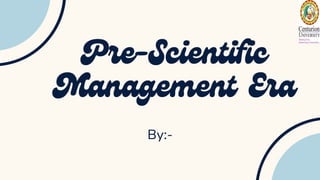
Blue and White Abstract Modern Simple Creative Portfolio Presentation.pdf
- 2. Introduction “Management is an art of getting things done through others”. “To manage is to forecast and plan, organize, command, coordinate and control”. Management is also organizing planning, staffing, directing, and controlling to determine and accomplish the organization’s objective.
- 3. Pre-Scientific The pre-scientific era in management refers to a time in history before the development of systematic and scientific approaches to managing organizations and businesses. The era fundamental to modern management. During this era ,management practices were often based on tradition, intuition, and personal experience rather than empirical evidence and structured principles. The pre-scientific era can be roughly categorized into several historical phases:
- 4. Sun Tzu was a Chinese military general, strategist, philosopher, and writer who lived during the Eastern Zhou period of 771 to 256 BC. Sun Tzu is traditionally credited as the author of The Art of War Kautilya or Chanakya c. 350 - 283 B.C.E. was an adviser and a Prime Minister to the first Mauryan Emperor Chandragupta (c. 340-293 B.C.E.), and architect of his rise to power.
- 5. The Bhagavad-gita is considered a complete guide to increase the efficiency and effectiveness of employees in achieving their intended goals by spreading ideas such as turning weaknesses into strengths. Niccolò Machiavelli was one of the most influential political theorists of Western philosophy. His most read treatise, The Prince, turned Aristotle ’s theory of virtues upside down, shaking the European conception of government at its foundations
- 6. SUN TZU • He focused on understanding yourself (one’s strengths and weaknesses) and also understanding your enemy • the art of war teaches us to rely not on the likelihood of the enemy's not coming, but on our readiness to receive them • He estimated the success of war before the war started • Use minimal resources and win the battle
- 7. Mapping from war to business War- develop a major product/ go to market Generals- Leader/ managers Enemies- competitors Spying- Business intelligence
- 8. Kautilya Arthashatra For centuries to come and the centuries that went by, which recorded in history talking of great men and legendary characters. Chanakya perhaps is the only personality who has been accepted and revered as a genius both by Indian and western scholars. Kautilya’s Arthashastra , which is written by kautilya, also known as Chanakya, is an ancient Indian text that provides to governance, economic policies and principles of leadership and management. Arthashastra contains several principles , that are:-- Kautilya’s Arthashastra discusses the importance of a well-structured governance with defined rules and responsibilities. It focuses on organizational hierarchy and division of labor . It also focuses on the different leadership styles and decision making.
- 9. Kautilya Arthashatra It provides economic policies, trade regulations, and monetary systems. These discussions highlight the importance of economic planning and policy development, which have evolved into key components of strategic management in contemporary organizations. It assembles a capable and loyal team. Chanakya emphasized the importance of teamwork and unity which is called team building. The concept also discusses the discuses selection of the right people, provision of training, and managing officials and administrators for better HR management practices in the modern organization.
- 10. Shrimad Bhagavad Gita This sacred Hindu scripture contains teachings from Lord Krishna to Arjuna, focusing on ethical decision-making, leadership, and duty. The Bhagavad Gita emphasizes the importance of ethical leadership, self- discipline, and the alignment of personal values with organizational goals. The Shrimad Bhagavad Gita, often referred to as the Gita, is a 700-verse Hindu scripture that is part of the Indian epic Mahabharata. It consists of a conversation between Prince Arjuna and the god Krishna, who serves as his charioteer. While the Gita primarily addresses spiritual and philosophical themes, it also contains valuable lessons that can be applied to management and leadership. Some key learnings from the Bhagavad Gita from a management perspective:
- 11. Shrimad Bhagavad Gita 1- self awareness and self management 2- purposed and vision 3- duty and responsibility 4- decision-making 5- leadership style 6- managing conflicts 7- mindfulness and focus 8- team building
- 12. Niccolo Machiavelli Machiavelli proposed that the overwhelming responsibility of a good prince is to defend the state from external and internal threats to stable governance Machiavelli's work touches on the practical aspects of leadership, including the need for adaptability, effective communication, and the ability to make difficult decisions for the greater good. He focuses mainly on politics and governance Machiavelli's concern with the stability and preservation of states can be related to the management goal of ensuring the stability and sustainability of organizations
- 13. Niccolo Machiavelli Machiavelli's concern with the stability and preservation of states can be related to the management goal of ensuring the stability and sustainability of organizations Machiavelli's works often draw lessons from historical events. Managers can adopt a similar approach by studying past successes and failures in their industry to inform decision-making.